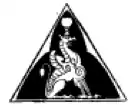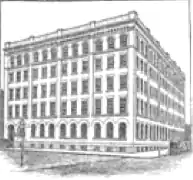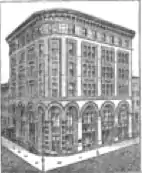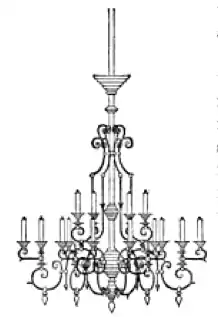Archer & Pancoast Manufacturing Company
Archer & Pancoast Manufacturing Company was a US gas fixtures manufacturing company. It was located at No. 67 Greene Street, and Nos. 68 to 74 Wooster Street, in New York City, New York. Archer & Pancoast Manufacturing Company manufactured fixtures for gas and electric lights -- separately for gas or electricity, or combined for both. The fixtures were found in the residences of the Vanderbilts and Marquands of New York, as well as Potter Palmer's of Chicago. They also equipped Madison Square Garden, Manhattan Athletic Club, Equitable Life, and United States Trust. In San Francisco, their work appeared in the Palace Hotel; in Indianapolis, in the Indiana State Capitol; and in Hartford, in the Connecticut State Capitol.[1]



History

This business was originally established as Archer, Pancoast & Company, in 1859, the co-partnership consisting of Ellis S. Archer, William C. Ellison and George Pancoast. From a modest beginning, the operations of business steadily grew, and in a few years it had won a national reputation for the artistic excellence of its products. In 1868, the business had increased to such extensive proportions that a stock company was organized and incorporated under the laws of New York State, with a capital of US$300,000. The mammoth factory and warehouse were located at No. 67 Greene Street, extending through to Nos. 68, 70, 72 and 74 Wooster Street. The factory was arranged and equipped with the modern machinery and appliances, the majority of which were specially designed and built for these works. A force of 350 skilled mechanics was employed at one time. Each department was under the management of a manager, and the whole was regulated by a system which both facilitated business and assured the prompt execution of orders.
The position that Archer & Pancoast attained in the production of gas fixtures, chandeliers, electric light fixtures and artistic metal work was universally recognized throughout the US. Their show rooms featured displays, one of which was a great attraction to visitors. The company fitted up with gas-fixtures some of the largest public edifices throughout the country. Hundreds of New York's palatial private residences and extensive commercial buildings also contained their artistic products. The company did an extensive wholesale trade throughout the country. They had branch offices located in Boston and Chicago, both of which were heavily stocked with their specialties.[3]
As the business grew, Robert and Ogden Goelet erected 900 Broadway, a new and extensive building for Archer & Pancoast at 20th Street and Broadway.[3] The factory was a six-story brick building, erected in 1888.[1] The Archer & Pancoast Company, incorporated in 1868. It had a paid-up capital of $600,000 by 1892, and employed 500 workmen.
By 1896, the Archer & Pancoast Company had salesrooms at Nos. 18 and 20 West 25th Street, Manhattan, and a factory at Flushing and Carlton avenues, Brooklyn. It went into the hands of receivers, on August 19, 1896. Justice Smyth, of the Supreme Court appointed Albert C. Hetherington, William S. Fearing and Peter F. Meyer receivers, with a bond of $100,000, on the application of President Pancoast and other directors of the company. Mr. Fearing was vice-president and general manager; Paul Thompson, treasurer and Mr. Hetherington, a director. Thomas B. Odell was appointed referee, and the order to show cause for the dissolution was set down for February 5, 1897. It was said by the officers that the company was insolvent, that it had recently found it impossible to obtain money in any considerable quantity owing to the financial stringency all over the US, and that within the last week, the bank with which the company had always done business had refused further to extend its line of discount. To save the assets from slaughter and make the best possible disposition of the property, the officers deemed it best to apply for receivers. The total liabilities are $806,780, and the nominal assets $821,063. Of the liabilities, $705,017 were mortgage liens on all the property of the company, except accounts receivable. These mortgages were for purchase money of factory, $55,000; to secure notes, $267,482, and to secure income bonds, $378,465. There was due for merchandise $51,025 and for loans by stockholders $37,074. The assets consisted of real estate and factory in Brooklyn, $200,000; machinery, $201,552; models, patterns, $100,000; merchandise, $139,037; improvements at factory, $17,844; store fixtures, $12,000; goods in the New York store, $37,067; stock of other companies, $11,000; and accounts receivable, $102,563. Of the accounts, $18,000 was probably uncollectable, and $14,414 had been pledged to secure advances. The officers believed that there would be no equity in the assets which were covered by the mortgage liens leaving only the accounts to pay the unsecured debts. The company did not have Bradstreet's rating. It was a reorganization of the old Archer & Pancoast Manufacturing Company, which went into the hands of receivers in May 1893, with liabilities of $1,100,000. The property was sold to the Reorganization Committee tor $600,000. and the newer company was formed by the creditors in November, 1894, to carry on the business. About 400 persons were employed by the company at this time.[4]
References
 This article incorporates text from a publication now in the public domain: The Electrical Engineer's "The Electrical Engineer: A Weekly Review of Theoretical and Applied Electricity" (1896)
This article incorporates text from a publication now in the public domain: The Electrical Engineer's "The Electrical Engineer: A Weekly Review of Theoretical and Applied Electricity" (1896) This article incorporates text from a publication now in the public domain: Historical Publishing Company's "Finance and Industry: The New York Stock Exchange : Banks, Bankers, Business Houses, and Moneyed Institutions : the Great Metropolis of the United States : Copyrighted" (1886)
This article incorporates text from a publication now in the public domain: Historical Publishing Company's "Finance and Industry: The New York Stock Exchange : Banks, Bankers, Business Houses, and Moneyed Institutions : the Great Metropolis of the United States : Copyrighted" (1886) This article incorporates text from a publication now in the public domain: M. F. Sweetser's "King's Handbook of the United States" (1892)
This article incorporates text from a publication now in the public domain: M. F. Sweetser's "King's Handbook of the United States" (1892)
- Sweetser 1892, p. 634.
- Holly, Henry Hudson (1878). Modern Dwellings in Town and Country Adapted to American Wants and Climate: With a Treatise on Furniture and Decoration (Public domain ed.). Harper & Brothers, Publishers. pp. 212–.
- Historical Publishing Company 1886, p. 188.
- The Electrical Engineer 1896, p. 206.
Bibliography
- The Electrical Engineer (1896). The Electrical Engineer: A Weekly Review of Theoretical and Applied Electricity (Public domain ed.). Williams & Company.CS1 maint: ref=harv (link)
- Historical Publishing Company (1886). Finance and Industry: The New York Stock Exchange : Banks, Bankers, Business Houses, and Moneyed Institutions : the Great Metropolis of the United States : Copyrighted (Public domain ed.). New York, New York: Historical Publishing Company.CS1 maint: ref=harv (link)
- Sweetser, Moses Foster (1892). King's Handbook of the United States (Public domain ed.). Moses King Corporation.CS1 maint: ref=harv (link)